Updated: 10-Jan-2020
The factory is called "Austro-Daimler Motoren Gesellschaft", or rather "Österreichische Daimler-Motoren AG".
-Located in Vienna, Neustadt. Around 1909.
-In the casted blocks of these engines sometimes there appeared these letters in relief: ODMAG superimposed as in the following drawing.

"Casted marks"
-At that time they produced two interesting engine types: the 35/40 CV with 80 kg of weight and the 65 CV.
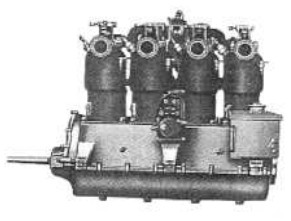
"Austro-Daimler, 40 CV"
-In the four-cylinder CV 35/40, wherein, among the four cylinders, we can see the magneto driven by a shaft at an angle of 90° to the crankshaft.
-In the following figure we will see that the same shaft at the other side drives a water pump, and above it a carburetor.

"40 CV, water pump side"
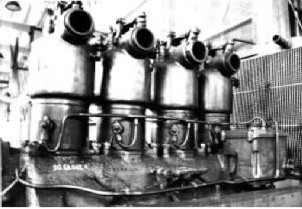
"40 CV, left side"
-On the left side lacks the magnet and remains the block base. Behind it is the water radiator and on this side we see the "lubrication box", and we clearly see the tube that greases the walls of each cylinder.
-This engine is exposed in the Közlekedési museum in Hungary.
-The 40 CV are reached at 1400 rpm. The the pistons' measurements of diameter by stroke were 100 by 120 mm.
-The engine that followed was the one that gave 65 CV at 1,350 rpm. It had pistons with a diameter of 120 mm and a stroke of 140 mm.
-The “lubrication box” as well as the water pump and the magneto were clearly at the rear.
-The “lubrication box” was a unit that had a Bosch pump, which was very common in a lot of engines then.
-The Turin Polytechnic Institute has an Austro Daimler four-cylinder model AD4 in their Capetti collection of aircraft engines. It is next to an AD6.
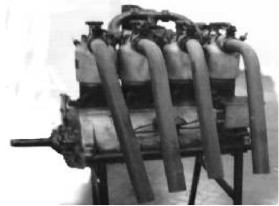
"Austro Daimler AD4"
-It has loose cylinders. As an interesting point, we see the lubrication box at the left-rear side, though incomplete, because the top cover is missing and it is empty.
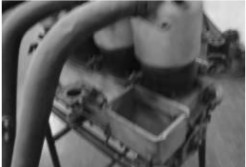
"Empty box details"
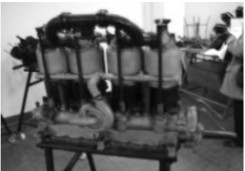
"View from the other side"
-Furthermore, the ends of the rocker arm had a Stauffer lubricator of consistent grease.
-The carburetor was very similar to the French automatic Claudel type.

"Austro Daimler with four cylinders"
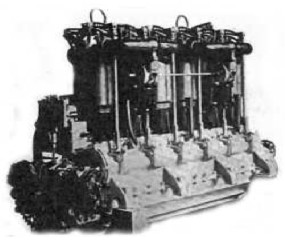
"Austro Daimler with six cylinders"
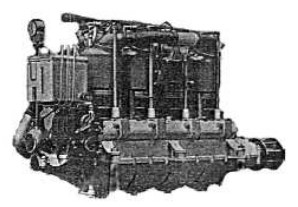
"Austro-Daimler, 65 CV"
-We note that from the lubrication box hovers a manometer facing the pilot.
-The Austro Daimler engines were designed by Ferdinand Porsche.
-They were very successful to the point of being manufactured under license in Scotland by “Arrol-Johnston” and “Beardmore and Son”, among other manufacturers in different countries.
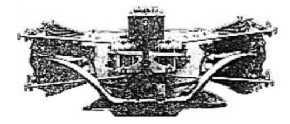
Austro-Daimler two-cylinder"
-During the period 1912-13 appeared a two-cylinder engine -not that small- with a displacement of 10 liters giving 65 Kw (90 CV).
- The boxer design would be a future Porsche reference. It was air cooled.
-The first liquid-cooled, upright 6-cylinder engines are from 1910. The first model gave 90 CV with single ignition and later appeared the well known model that gave 120 CV.
-The pistons had a diameter of 130 mm and a stroke of 175 mm.

“Austro-Daimler, 90 CV”
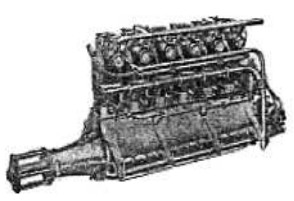
"Austro-Daimler, 120 CV"
-The prestige of Austro-Daimler was growing with events: in 1912, the Cody biplane won 500 pounds in the "Military Trials" with a 120 CV engine of this brand.
-The 65 CVs were installed in Lohner Bs; The 160/185 CVs in Lohner C.1s; a 160 CV was installed in a British DH-1a, etc.

"Austro-Daimler, 120 CV"

"Austro Daimler 120, other view"
-The 120 CV engine has been developed until reaching 140 CV at 1,200 rpm.
-This Austro-Daimler 162 CV (119 kW), exhibited at the Kosice Museum, was manufactured in 1919, and was used in the Austrian Lohner C.1 aircraft.
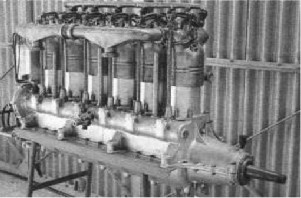
"Austro Daimler, 162 CV"
-The 180 CV version generally was similar to the above mentioned engines. A difference was that the camshaft was on top of the cylinders and the transmission to the camshaft at the front.
-The magnetos of the 180/185 are placed on the block at the front of the engine, and they are driven by the camshaft's transmission.
-The cylinders are still Individual, but a single carburetor feeds the cylinders in threes with two main induction collector ducts. This would continue with the 200/225 CV engines.

"180 CV front view"
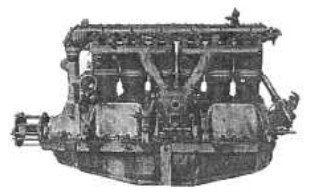
"185 CV side view"
-During the last half of WWII appears the 200 CV, similar to the above but with a much more refined shape as we can see in the following two photographs.
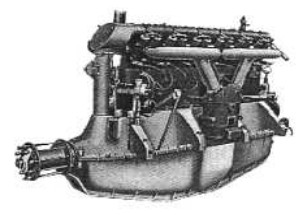
"Austro-Daimler, 200 CV"

"Austro-Daimler, 200 CV"
-Like all these engines from German speaking countries, some of their accessories came from Germany, like the Bosch magnetos, or the lubrication system discussed above. It had a great two barrel Austro-Daimler Duplex carburetor. The engine had double ignition.
-Like most engines of that time the compression was 5: 1, or a little more, because of fuel poverty. The oil sump had integral cast fins.
-At the "Politecnico di Torino" there is a 225 CV engine presented as AD-6, designed by Ferdinand Porsche and derived from the AD-4 (Austro Daimler 4-cylinder). Though one detail indicates that it was built in Hungary by MAG.
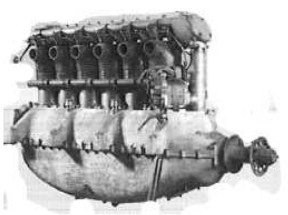
"Austro-Daimler MAG?, 225 CV"
-We obtained a picture of the 360 CV engine. This engine requires a characteristic vision due to the intake manifold. With six upright cylinders in line, it was intended for use in airships. It had four valves per cylinder and a displacement of 1,680 cu. in..

"Austro Daimler, 360 CV"
-Regarding the construction of V engines, Austro Daimler, already in 1912-13, made a two-cylinder V engine (In the same period of the opposed-cylinder engines). The design was done by F. Porsche.
-Finally came the 400 CV Austro Daimler. It was a V-12 known under the name of D-35. The V was at 60°.

"Austro Daimler, 400 CV"
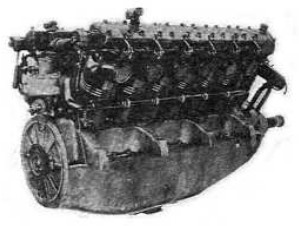
"Austro Daimler V-35"
-The V-35 model had the following power/rpm relations :
-342 CV at 1,200 rpm.
-376 CV at 1,400 rpm.
-382 CV at 1,500 rpm.
-This 12-cylinder V engine consisted of two cylinder blocks from the 210 CV engine.
From appendix A1/6: An AD-6 engine has now been restored and tested in Austria, as we see in the following picture by K. Mayrhofer that appeared in the Aero magazine.
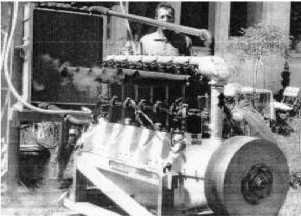
"AD-6, rotating slowly"
-It is specifically the AD-6 engine with serial number 23605.
-Today it is in the Magna-Engineering Center- Steyr, in the city of Steyr that recovered it "forgotten" in the very Steyr factory itself. It is known that it had belonged to some WWI airship.
-Apart of the AD-6 engine as a part of the engine stock of the Polito di Torino, another one is located at the Wiener Neustädter Stadtmuseum, with serial number 23527 and still another AD-6 at Heeresgeschitliches Museum in Vienna, serial number 23537.
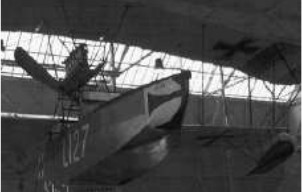
"Lohner LA.4"
-At the Regia Aeronautica Museum in Vigna di Valle is a biplane flying boat with an Austro Daimler engine that is oriented correctly for traction, and it has its propeller drive at the rear, in the accessories area, which we assume altered.
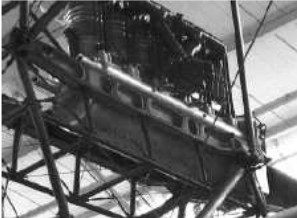
"Austro Daimler mounted in Lohner LA.4"
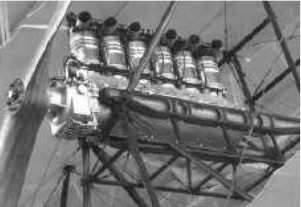
"Propeller mounted on the rear"
-Between the rear drive of the crankshaft and the propeller we see the integrated lubrication box with several oil duct outlets below it.
-This engine comprises as 140/180 CV. It still had push rods and rocker arms instead of the more advanced camshaft on the cylinder head.
-And it is precisely on this engine that we find a different logo that does not show ODMAG as on other engines of this brand, but a very different one, half-visible from the hangar floor where the aircraft is exposed. Or rather, badly repainted.

"Logos hardly visible on the crankcase"
-On February 23, 2009 we received a letter from the Regia Aeronautica Museum in Vigna di Valle. In this letter they cleared up that the engine of the exposed Lohner aircraft is a Hiero engine, which was built under license by the Warchalowski Eissler & Co. (Hiero engines were an alternative to the Austro Daimler in this type of aircraft, and they always had the same power).
-Now we present the Austro Daimler that is exposed with reference DM-200 at the Air Museum in Krakow, Poland.
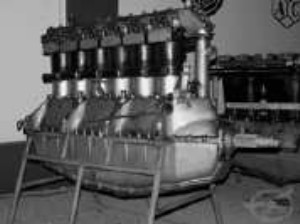
"Austro-Daimler DM-200"
From appendix 7: According to Ing. W. Isendahl, by 1913 the brand offered three engines:
-The 35-40 CV with four cylinders in line.
-The 65-70 CV with four cylinders in line.
-The 6-cylinder inline that gave 120 CV.
From appendix 9: A 12-cylinder V engine of this brand giving 250 CV.
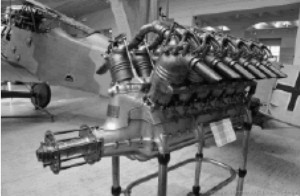
"Austro Daimler V-12 in Vienna" (E-V)
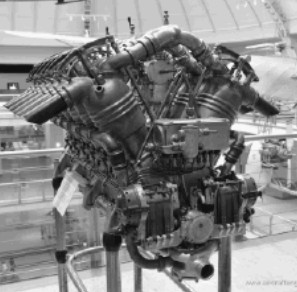
"Austro Daimler V-12 in Vienna, rear view"
-We see the magnetos on top of the box with the little lubrication pumps. And in the lower part of the engine, the water pump, as usual.
-Austro-Daimler is also ODMAG, an acronym for Osterreicher Daimler Motoren AktienseGellshaft.
-At the same museum there are a 150 CV and a 65 CV.
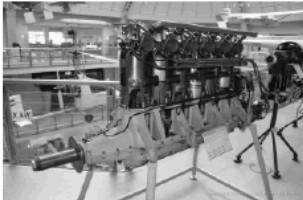
“Austro-Daimler 150 CV” (E-V)
-The 150 CV engine with six cylinders in the photograph above, has a longer propeller drive extension than normal.
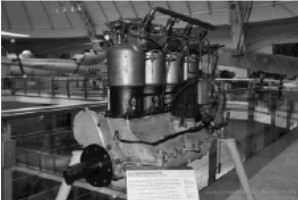
"Austro-Daimler de 65 CV"
-The four-cylinder 65 CV is identified by having the magneto on the left side, between the two central cylinders, and the water pump on the opposite side, in the same place.
-On the rear side is the lubrication box, like on the brand's other engines of that time.
-The 6-cylinder model.
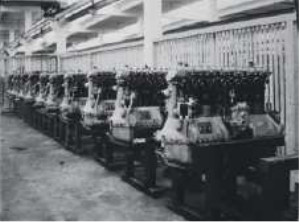
"Prepared for shipping"

"Model from previous years with descendent carburetor and lubrication box"
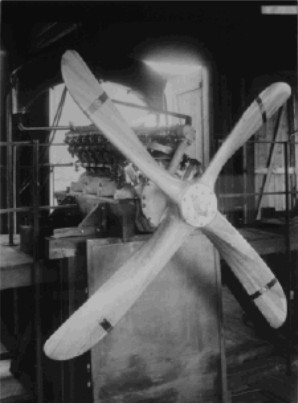
"V engine on test bench"
It is a 12-cylinder engine with the V at 60°. It has double ignition with magnetos at the front and it is water cooled. It was a Ferdinand Porsche design.
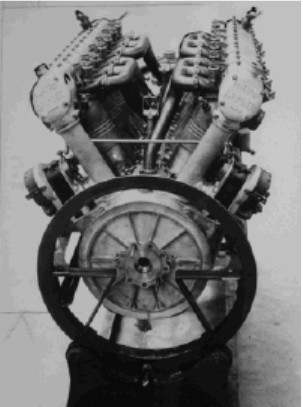
"The same engine as above on a work bench”
From appendix 10: The D-35 and V-35 are 12-cylinder V engines and they reach 400 CV. As described in the main text.
-Now we have some photographs from Evzen Vstecka, contributor from his magnificant website, who, through his visit at the Vienna Museum, recovered the images for memory. It is a V-12 that gave 300 CV at 1500 rpm.
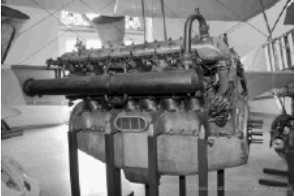
"Austro-Daimler V12, 300 CV"
-It was designed by Ferdinand Porsche in 1915/16 and was built by Austro-Daimler (Osterreische-Daimler-Machinenfabrick-AG), also known as ODMAG.

"A front view of the same enginel" (E-V, AEHS)
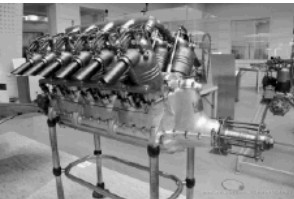
"Another AD, V-12 giving 250 CV" (E-V, AEHS)
-Another Austro Daimler 250 CV engine with the V-12 formula, also located in Vienna.
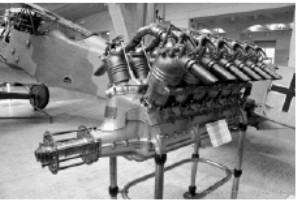
"The same AD, V12 with 250 CV from above" (E-V, AEHS)
-The AD6 that is not presented in the main text is shown below. It gives 150 CV.
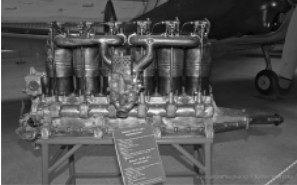
“Austro-Daimler AD-6” (E-V, AEHS)
-A sight at the Szolnok Museum in Hungary.
-New photo for the 6-cylinder, 90 CV Austro-Daimler engine from 1914 with water jackets that have a copper layer precipitated by electrolysis.

“Austro-Daimler de 90 CV”
-On the rear side there is the lubrication system box with its pistons to send pressurized oil to the various points. On top it has a pressure gauge.
-We also see two suspension rings on top. And the two carburetors of this engine model are clearly visible.
Engines of AUSTRO DAIMLER
Model: 2 cils, en V
Model: 2 cils. boxer

"Austro-Daimler - Two cylinders"
Model: 4 cils. 35/40 CV

"Austro-Daimler - 40 CV, left side"
Model: 4 cils. 65 CV (AD-4)

"Austro-Daimler, 65 CV"
Model: 6 cils. 120 CV

"Austro-Daimler, 120 CV"
Model: 6 cils. 150 CV
Model: 6 cils. 160 CV
Model: 6 cils. 180 CV
Model: 6 cils. 200/225 CV (AD-6)

"Austro-Daimler, 200 CV"
Model: 6 cils. 90 CV

"Austro-Daimler, 90 CV"
Model: D-35
Model: DM-200, 6 cils.
Arquitecture:
Cooling:
Total Displacement:
Bore / Stroke:
Power: @ rpm
Weight:
A liquid-cooled, upright 6-cylinder engine. It gave 200 CV.
It had a great two barrel Austro-Daimler Duplex carburetor. The engine had double ignition.
Like most engines of that time the compression was 5: 1, or a little more, because of fuel poverty. The oil sump had integral cast fins.

"Austro-Daimler DM-200"
Model: V-35, 12V, 400 CV

"Austro Daimler - V-12 in Vienna"


